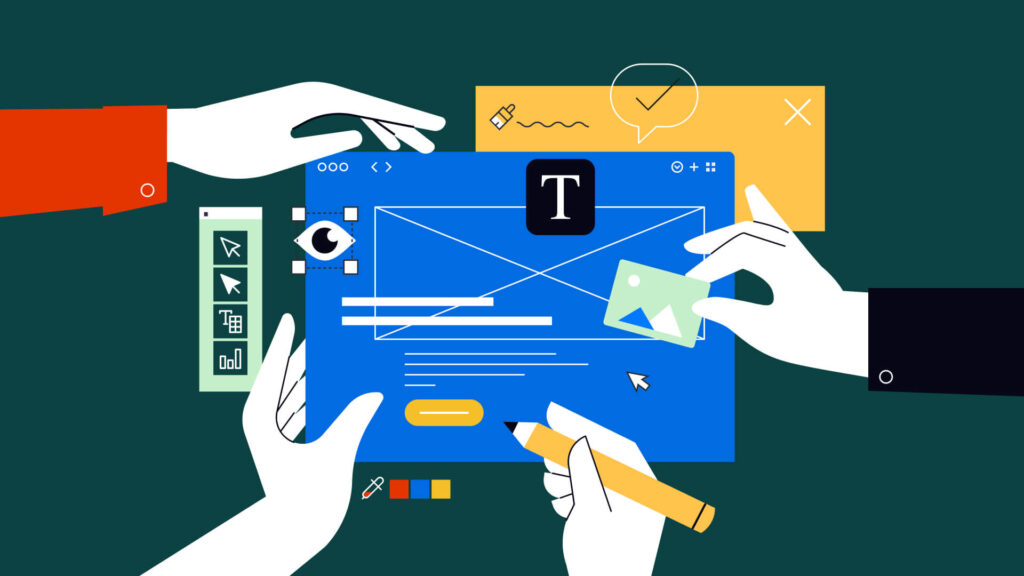Collaboration in creative work to boost efficiency? Yes, please
Have you heard of the term, ‘cross-functional collaboration’? It’s a model, or form of project management, that sees synergy between multiple teams and functions.
In this article, we’ll look at the benefits and key elements to successfully adopting collaboration between departments, and give you the tools to overcome the challenges you may face, so that you and your business can reap the rewards when implementing this way of working.
3 (of the many) benefits of cross-functional collaboration
Bringing together individuals from various departments and backgrounds drives innovation, solves complex problems, and gives efficiency a well-deserved boost.
- Enhanced creativity and innovation
When individuals from different disciplines come together–be it marketing, design, UX/UI, copy, or legal–they bring unique perspectives and skills to the table. Diverse ideas create a powerful catalyst for creativity and innovation, leading to solutions that may not have emerged within a single-function team.
- Improved problem-solving
One of the key advantages of collaboration between teams is improved problem-solving. Two heads are better than one, after all. To achieve efficient project management and outcomes, issues need to be resolved quickly.
Different team members bring unique approaches to tackling challenges, helping to identify the most effective and efficient solutions to complex problems and ultimately, leading to better project outcomes.
- Increased efficiency and productivity
By streamlining processes and optimizing resource management, cross-functional teams can work more cohesively and achieve goals faster. When everyone understands their role and how it fits into the bigger picture, tasks are completed more swiftly and with fewer bottlenecks.
4 key elements for successful cross-functional collaboration
- Everything stems from clear communication
As with all forms of project management and collaboration in creative work, clear communication is paramount. It’s fundamentally essential. At all costs, make sure your cross-functional team has open and transparent communication channels.
Regular meetings, updates, and collaborative tools ensure everyone is on the same page, minimizing misunderstandings to keep the team aligned with project goals.
- Get crystal clear with defined roles and responsibilities
Now everyone can communicate, define roles and responsibilities clearly so everyone knows who’s who, and who’s responsible for what part of the project.
Each team member should understand their contribution and how it fits into the overall project because clarity prevents overlap and ensures that all tasks are covered efficiently.
- Mutual respect and trust
What’s a team without mutual respect and trust? When team members respect each other’s expertise and trust in their capabilities, collaboration becomes effortless.
Space for ideas, open dialogue and respectful critique will strengthen team performance.
- Shared goals and vision
Establish the goal of the project at the beginning, and make sure each team member is aligned and energized by the vision through common objectives.
Harmony comes from all members striving for the same outcome and ensures that brand identity and project briefs stay in check.
Ultimately, when all contributors are working toward the same end goal, conflicts are reduced and productivity soars.
An example of success: Slack
When we look at this model in practice, Slack’s success can be attributed to cross-functional teams working so closely, and effectively, together.
To make the product work, teams from product development, user experience (UX) design, marketing, customer support and legal must work seamlessly together. The product wouldn’t exist without input from each discipline, and one area cannot be created without the other.
For example, without legal input, the copy teams can’t finish their words, and without the UX designers, marketing can’t develop their campaigns based on user benefit.
This collaborative culture has enabled Slack to create a tool that enhances communication and productivity for millions of users worldwide.
3 challenges you may face–and how to overcome them
Cross-functional collaboration offers numerous benefits, but it is not without its challenges.
- Miscommunication
When team members come from different departments, they often use specialized jargon and have varying communication styles leading to misunderstandings, information gaps, and errors.
Solutions:
- Implement standardized communication tools and practices (Slack, Microsoft Teams, Asana)
- Schedule regular check-ins/feedback sessions
- Conduct training sessions on department-specific jargon
- Conflicting Priorities
Cross-functional teams often consist of members with different departmental goals and priorities, causing tension. For instance, the marketing team may focus on brand messaging, while the engineering team prioritizes technical feasibility.
Solutions:
- Clearly define the project’s overarching goals
- Involve representatives from all departments in the planning phase
- Appoint a project manager to oversee and prioritize tasks.
- Resistance to Change
Collaboration in creative work often requires changes in established workflows and practices. Some team members may resist these changes, preferring to stick to their familiar routines.
Solutions:
- Implement training and clear communication about benefits
- Include team members in decision-making to increase buy-in
- Introduce changes gradually to ease the transition.
Enhanced creativity creates effective teams
Embracing cross-functional collaboration can transform your projects and propel your team’s efforts. It can enhance creativity, improve problem-solving, and increase efficiency, driving better project outcomes and overall business success. And while challenges may arise, they can be overcome with the right strategies and mindset.
Ready to embrace collaboration? The design team here at Design Force would love to be a part of your journey. Reach out to discuss how we can collaborate on your next creative project, or head to our Insights for more articles like this–we cover design, project management, and creative inspiration.



